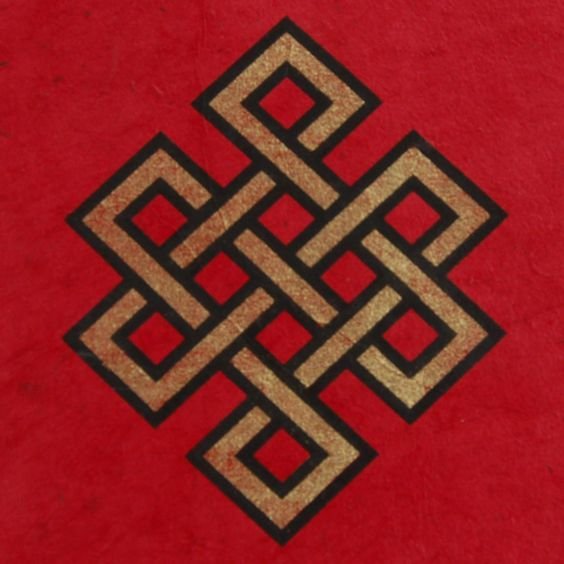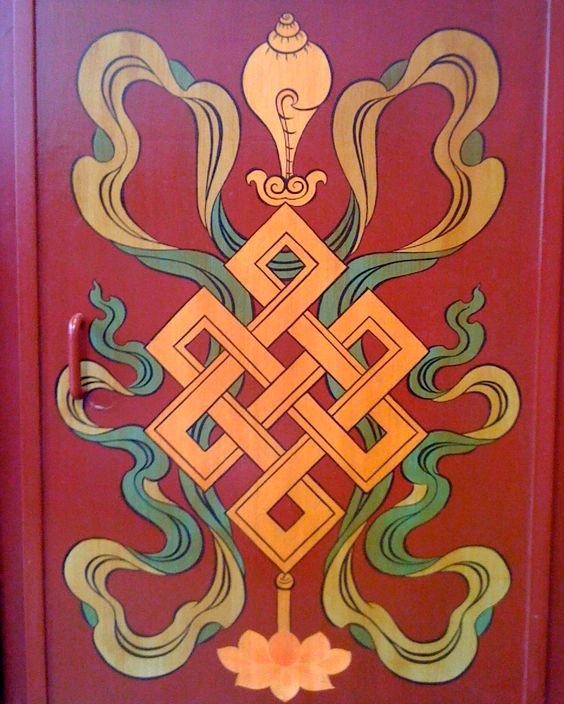Decoding Symbols of Hinduism: Srivatsa

Shrivatsa or Srivatsa is a Sanskrit word that means the beloved of Sri. It a triangular shape mark that is said to appear on the right side of Vishnu’s chest—one of the major Hindu deities and one of the three creator deity. The triangular mark, depicted as a looped knot or a set of interlocking lines direct relation with the god makes the symbol auspicious and full of reverence amongst the devotees of the Hindu religion. In Hindu mythology, the Srivatsa symbol is often associated with god Vishnu, one of the principal deities of Hinduism, also known as the preserver of the universe.

The symbol’s mystic loop has fascinated scholars and devotees alike for centuries. The origins of the Srivatsa symbol are shrouded in antiquity, with references found in ancient Hindu scriptures such as the Vedas and the Puranas. The Vedas are the ancient scriptures dating back thousands of years, is a scripture that mainly contains hymns and rituals that form the basic foundation of Hindu religious practices. The roots of Srivatsa symbol can be found rooted in the Vedic rituals associated with fertility, abundance, and divine blessings. In Sanskirt, the vatsa in Srivatsa means calf; and in Hinduism the cow is seen as an auspicious animal symbolizing prosperity and sustenance as per the Vedic rituals and teachings. Thus, the term Vatsa can be interpreted as a representation of fertility, growth, and abundance. The symbols former word Sri in Vedic concept too consists of notions of prosperity, fortune, and auspiciousness. These notions are related to the symbolism of Srivatsa.

In Hindu Puranas, ancient texts that recount stories of gods, goddesses, and divine incarnations also mention the Srivatsa symbol. One significant mentions of the symbol is narrated in the divine exploits of Lord Vishnu, in his avatar as Krishna. In the Bhagvata Purana, one of the Puranas texts which mainly focuses on the life and teachings of Krishna, the Srivatsa symbol is described as a mark on Krishna’s chest, symbolizing his divine nature and supremacy. In Bhagvata Purana there are many narrations where the symbol is mentioned, including Krishna’s interactions with devotees, his lila, and his part in defeating the evil. In one of the narrations it is narrated that a number of sages had gathered together at the banks of Sarasvati River to perform a Yajna—a vedic ritual of chanting mantras in front of a fire—and fell into a dispute regarding the superiority of the three creator deities also called the Trimurti and one of the sage named Bhrigu was appointed to unravel the truth. One by one he went to the abodes of the three gods, and according to the Bhagvata Purana, when the sage reached the abode of Vishnu he found him sleeping despite of his role as the preserver of the universe. To wake Vishnu up, Bhrigu kicked his chest and it is believed the Srivatsa emerged from there, and continued to remain on Vishnu’s chest.

According to Hindu belief it is also said that the Srivatsa is closely associated with Goddess Lakshmi, the divine consort of Lord Vishnu. Although the symbol generally adorns the chest of Vishnu, its importance extends to Goddess Lakshmi as well. In Hindu iconography, the goddess is depicted alongside Vishnu, and the depiction of Srivatsa symbol on Vishnu’s chest serves as a representation of the goddess’s presence and her divine relations with Vishnu. In the mythology, the goddess Lakshmi is said to be residing in the heart of Lord Vishnu, which symbolizes their eternal union and inseparable bond. The Srivatsa on Vishnu’s chest is then viewed as a symbol of the goddess eternal adobe and resting place within Vishnu’s heart.

The Srivatsa symbol holds deep philosophical significance within Hindu theology and teachings. In it the symbol is understood as a representation of the eternal cycle of life, death, and rebirth known as samsara. Samsara is a fundamental aspect of Hindu philosophy which lays emphasis on the eternal journey of the soul through various lifetimes until the soul achieves moksha from the cycle of rebirth. The looping pattern of the Srivatsa symbol signifies the interconnectedness of all existence and the ongoing flow of energy in the universe. Like the loop of Srivatsa which has no beginning or end, similarly it is believed that the samsara is an eternal cycle without a definitive starting point or ending. The symbol holds divine presence within it and within the cycle of samsara. In Hinduism, the ultimate aim of each soul is to attain moksha from the cycle of rebirth in order to unite with the divine. The Srivatsa’s direct connection and its appearance on the chest of Vishnu and his avatar Krishna, represents the presence of divinity in every being which guides and protects them on their way towards higher spiritual realization. The Srivatsa, thus serves as a symbol of reminder of the impermanent nature of worldly existence and the eternal nature of the soul.

In Hindu iconography, the Srivatsa is portrayed alongside other auspicious symbols of Hinduism, like the conch, lotus, chakra and the gada. This sacred ensemble is known as the ‘shankha-chakra-gada-padma.’ The conch shells relation to the Srivatsa represents the divine wisdom and spiritual awakening. The Srivatsa and chakra together form the interconnectedness of all existence and the eternal journey of the soul. The Srivatsa and gada represents the divine protection, and the Srivatsa and lotus or padma signifies the purification of the soul and the attainment of spirituality in the worldly existence. The Shankha-chakra-gada-padma together embodies divine wisdom, divine protection, purity and auspiciousness. When these symbols are depicted with Srivatsa they guide the Hindu devotees towards moksha by freeing them from the cycle of samsara.

For centuries the Srivatsa symbol has been depicted in Indian art and architecture, representing its cultural and religious significance in the country. The symbol can be found carved into temples, sculptures, painted in paintings and other decorative art forms across the country. In architectures of Hindu temples, the Srivatsa is mostly seen carved on the doors, pillars, and ceilings. In the southern parts of India, the Srivatsa is carved on the pillars of temple entrances as a symbol of welcoming the devotees into sacred space of the temple. The symbol is also carved into religious sculptures. It is mostly found adorning the chest of Vishnu and his incarnations like Krishna. In Indian paintings of religious depictions and themes the symbol often is painted as a decorative element around the divine figures or as an adornment on sacred objects. These paintings are a visual representation of the spiritual concepts and mythological narratives, and the Srivatsa adds to the deeper meaning and symbolism behind the artwork.

The Srivatsa, a symbol of divine presence and a mark of one of the most revered deity of Hinduism, is linked to purification, abundance, fertility; the kindness of Vishnu and to the eternal union and abode of goddess Lakshmi. The symbol serves as a constant reminder for the devotees of Hinduism to continue to pursue higher spirituality leading them to the eventual attainment of moksha.


